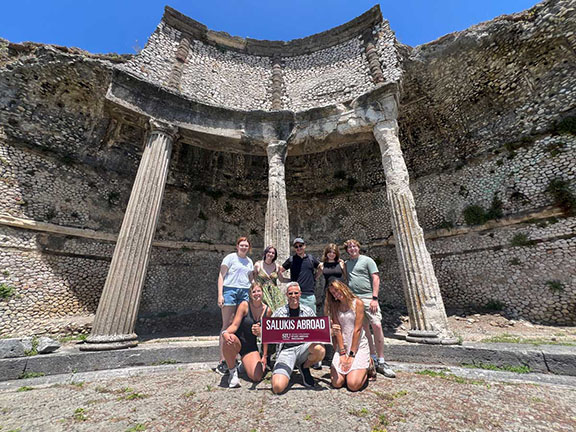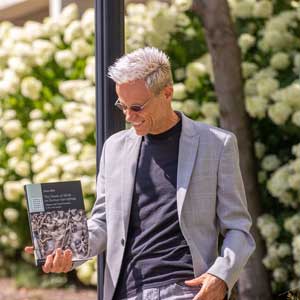By: Pete Rosenbery
CARBONDALE – From viewing centuries of distinctive Roman architecture, walking along the ancient, wagon-grooved streets of Pompeii or visiting the 12th century Basilica of San Clemente — where excavations have unearthed archaeological treasures dating back more than 2,200 years — a recent study abroad trip to Rome left a profound impact on several Southern Illinois University Carbondale students.

SIU Carbondale students and associate professor Mont Allen stand in front of the ancient Roman ruins of the Sanctuary of the Goddess Fortuna, built around 80 B.C., in Palestrina, Italy, during the group’s three-week study abroad trip to Rome. Allen has recently written a book detailing scenes from classical Greek mythology found on ancient Romans’ funerary art. (Study abroad photo by Mercedes Young)
“We did not only observe the history; we were also completely immersed in the culture around us,” said Madeleine M. Barhaug, a senior in art history and classics from Memphis, Tennessee. “The perspective that one gains when visiting Rome and her nearby ancient cities and towns is unlike any other.”
Barhaug and nine classmates spent three weeks starting in late May in Italy as part of The Art and Monuments of Ancient Rome course taught by Mont Allen, an associate professor with a cross appointment in art history in the College of Arts and Media and classics in the College of Liberal Arts.
Student-focused excursion
Allen, who has been to Rome six times, said the class offered him a chance to live vicariously through his students’ experiences — eight of whom had never been outside the United States. This was Allen’s first study abroad trip, and he plans to offer the class every two years.
“I knew it was going to be a life-changing experience for them, and I wanted to feed off their energy,” he said.

Mont Allen photo by Russell Bailey
Students noted one of Allen’s oft-used phrases is “when you go to Rome — not if — when.” The fine mix of ancient architecture in a modern city, minute details of carving in art works and even the smell and taste of food are not found in a book, Allen said.
“You can show them photographs in class, but nothing can convey the massive scale on which Rome was built except by being in something like the Colosseum yourself,” Allen said. “You just can’t process how bombastic Roman architecture is until you have inhabited these spaces yourself.”
Camaraderie, detailed discussions
Logan Shelton, a senior from Goreville, majoring in classics and history, said “every single day was very emotional, jaw dropping and profound,” adding that he “would not have wanted to take this trip with any other group.”
The trip gave Shelton, who already had an interest in the Roman emperor Nero to personally see “many of the things that I studied such as Julius Ceaser’s assassination, the Roman Forum and the Domus Aurea.”
“Stepping foot into any random Catholic church on the streets of Rome to be met with the most beautiful architecture, art and paintings that I’ve ever seen in my life never ceased to amaze me,” he said. “To think that all of what I saw in slideshows and read about in classes about ancient Rome was right in front of my eyes every day was something that never left me during the trip and never will.”
Mercedes Young, a senior in art history from Carbondale, echoed the closeness that the group developed with each other. They constantly asked each other questions and were excited to speculate and find the answer whenever and however they could.
“We continued to question and dissect things we had seen long after our walking lectures were over, making connections over the weeks between multiple sites or artifacts,” she said.
“One of the aspects of Rome and nearby towns that really struck me was the fact that ancient and modern structures coexist seamlessly in Rome and other Italian cities. There are historical sites that merge with modern-day homes, churches and corner stores. Even seeing stacked buildings with architectural features from the last 2,000 years in thick and distinct layers was so strange but truly impressive.”
“It was incredibly thought provoking to see churches built into the frames of ancient monuments — to see catacombs where paganism and Christianity drew no lines, figuratively or literally, between the people buried there.”
Barhaug recounts the hours spent learning with her classmates, now friends, marveling at the architecture, discussing over dinner topics including philosophy, art history, anthropology, classics and more. She noted the “otherworldly still of the Roman Forum, the intense magnitude of the Colosseum and the peace spilling out of every church.”
“Something that really stood out to me, however, was the reverence and love that modern-day Italians have for their ancient history,” Barhaug said. “Giant monuments are turned into museums, ancient cities are tirelessly preserved. The SPQR, a mark of Ancient Rome, is still branded on all facets of the city – from fountains to drains to police cars. Coming from what is still considered a fledgling nation, it was beautiful to see how proud Italians are of their abundance of heritage and history.”
Research, book on Roman sarcophagi
Allen’s 2022 book, “The Death of Myth on Roman Sarcophagi: Allegory and Visual Narrative in the Late Empire, ” provides greater understanding of classical mythology and funerary art — on the scenes from Greek mythology that ancient Romans chose to have carved on their coffins and their reasons for selecting these myths. The book will also soon be released in paperback, Allen said.
His present research centers on the practice of ancient Romans burying their dead in rounded sarcophagi, a shape that imitated that of wine vats, which invited the grieving family to imagine that their dearly beloved was not decomposing, but instead fermenting into wine. It allowed for the belief the person was “turning into something elevated; in Rome, wine is almost divine.”
Archeological sites still being found
The 12th century Basilica of San Clemente is “one of the most incredible experiences of how the ancient day supports the modern,” Allen said.
The church’s foundation is from a fourth century A.D. church; two stories below that is a set of first century A.D. Roman houses, and under that, a first century B.C. Roman house that at its lowest level has fresh water flowing through a portion of it.
“To look at that water and think that 2,200 years later that water is still flowing through an ancient Roman water system gives you chills,” Allen said.
The ancient system is 30 feet underneath modern rooms and cannot be tracked due to numerous reasons, including new archaeological sites that continue to open up, Allen said. Rome has only two subway lines because each time there is an effort to extend a tunnel an ancient Roman ruin is found and an archaeological assessment is required.
“As a result, even to this day they are still finding new discoveries and opening new museums in Rome,” he said. “It’s the gift that keeps on giving. It just never ends.”
